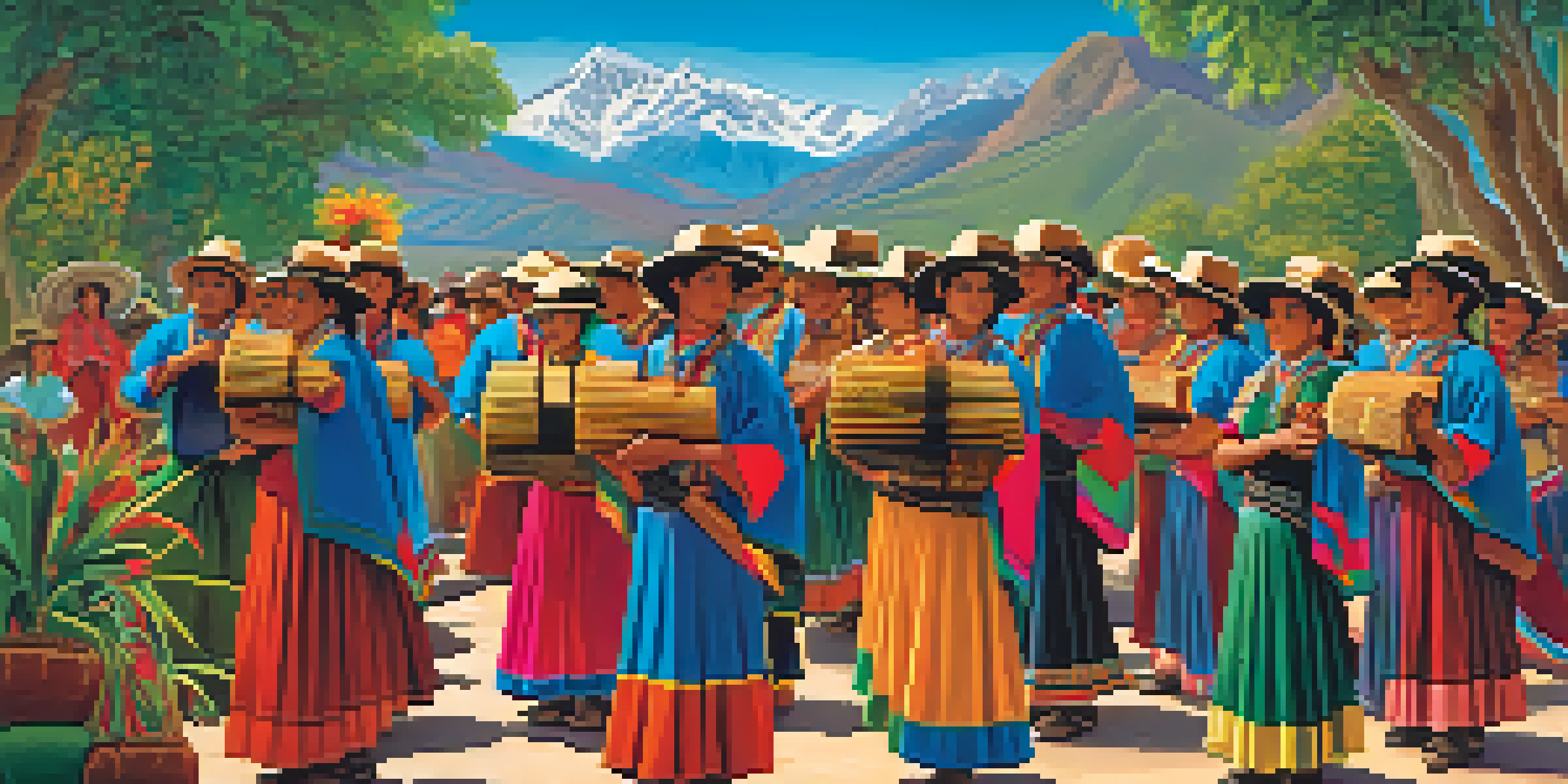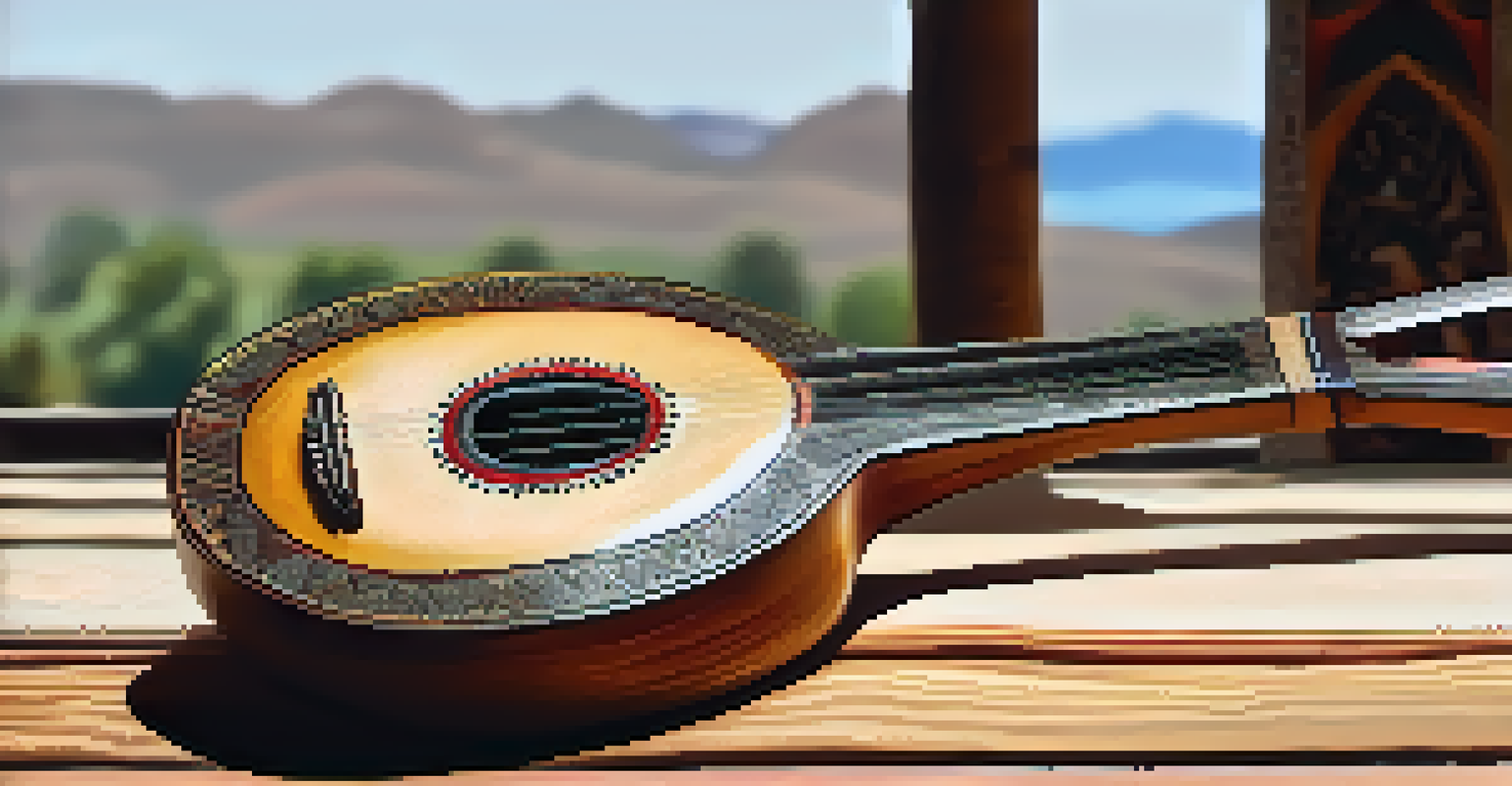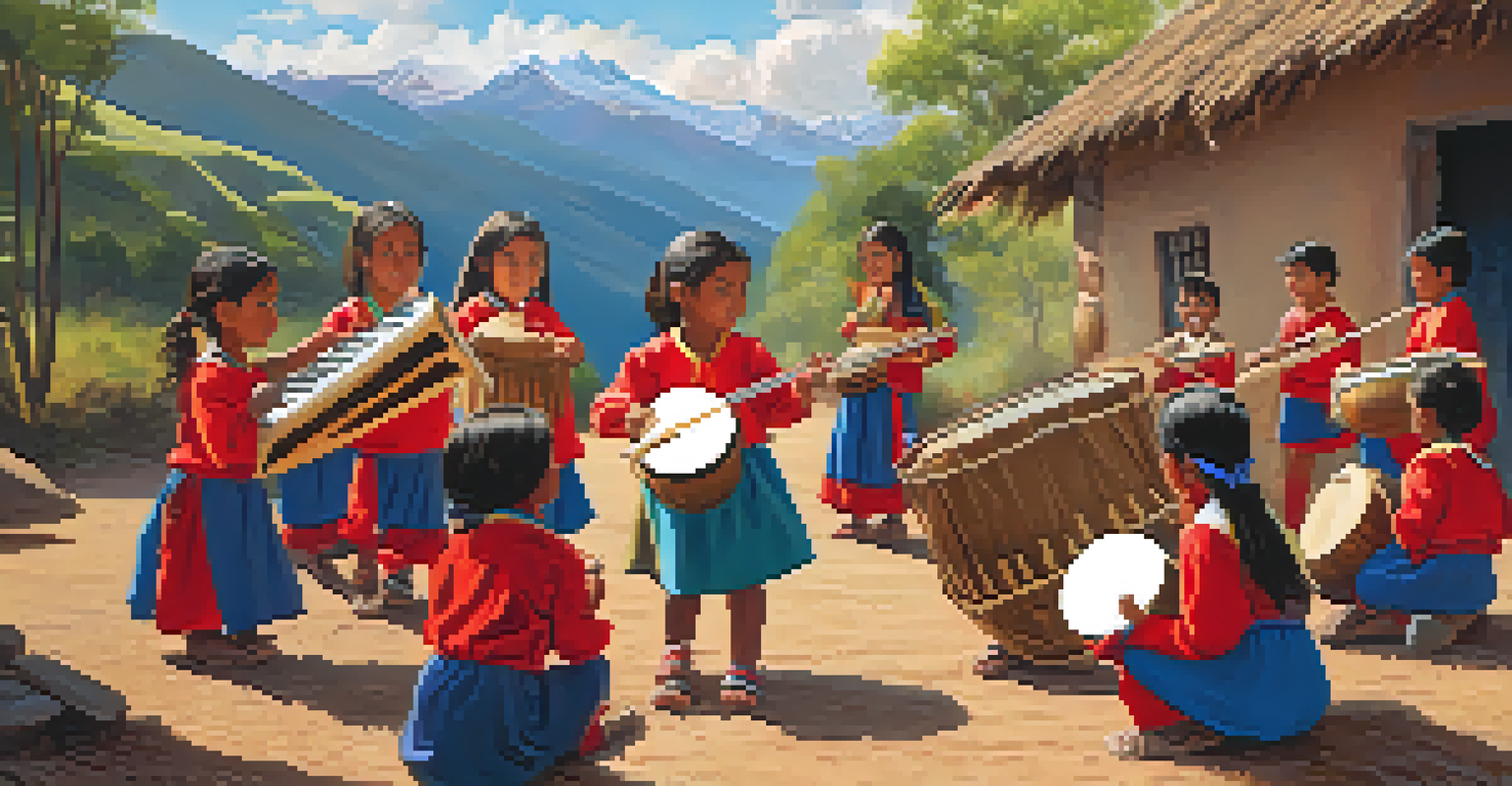The Sounds of the Andes: Traditional Music of South America

An Introduction to Andean Traditional Music
Andean music is a vibrant reflection of the cultures that inhabit the majestic Andes Mountains. It encompasses a variety of styles and instruments, each telling a unique story of the indigenous peoples. Traditional music often features themes of nature, spirituality, and daily life, showcasing the deep connection between the people and their environment.
Music is the shorthand of emotion.
Instruments like the pan flute, charango, and bombo drum are hallmarks of this genre. The pan flute, or 'sikus', produces enchanting melodies that can transport listeners to the high-altitude landscapes of Peru and Bolivia. Meanwhile, the charango, a small string instrument made from armadillo shells, adds a distinctive twang that is instantly recognizable.
As you explore Andean music, you'll notice how it serves as both a form of entertainment and a means of cultural preservation. Through songs and dances, traditions are passed down through generations, keeping the spirit of the Andes alive for future audiences.
Instruments that Define Andean Soundscapes
The sounds of the Andes are defined by a unique ensemble of instruments that create rich, layered melodies. The siku, or pan flute, is perhaps the most iconic, with its soothing, airy tones evoking the vastness of the Andean landscape. This instrument is often played in pairs, producing harmonies that echo through the valleys.

Another essential instrument is the charango, which, despite its small size, produces a bright and cheerful sound. Traditionally made from the shell of an armadillo, its strings resonate with the heart of Andean culture. Playing the charango is often a communal activity, bringing friends and families together in celebration.
Andean Music Reflects Cultural Identity
Andean music serves as a vital medium for storytelling and cultural preservation, connecting indigenous communities to their history and roots.
Drums like the bombo add rhythmic depth to Andean music, driving the beat for dances and festivities. These instruments not only provide a musical backdrop but also connect the performers to their ancestors, making each performance a tribute to the rich history of the region.
The Cultural Significance of Andean Music
Andean music is deeply entwined with the cultural identity of the regions it originates from. It serves as a medium for storytelling, preserving the myths and legends of indigenous communities. By singing these tales, musicians keep their history alive, ensuring that younger generations can connect with their roots.
Without music, life would be a mistake.
Music is also a vital part of various ceremonies and festivals throughout the Andes. Whether it's a harvest celebration or a religious ritual, traditional songs and dances play a crucial role in the festivities. These gatherings not only reinforce cultural bonds but also foster a sense of belonging among community members.
Moreover, Andean music promotes unity among diverse cultures within South America. As artists collaborate and share their musical heritage, they create a tapestry of sounds that reflects the region's rich diversity, bridging gaps between different communities and fostering mutual respect.
Modern Influences on Traditional Andean Music
While traditional Andean music remains vibrant, it has also evolved over time, incorporating modern influences. Contemporary artists often blend traditional sounds with genres such as pop, rock, and jazz, creating a fusion that resonates with younger audiences. This evolution has breathed new life into Andean music, making it more accessible to a global audience.
One notable example is the rise of Andean pop music, where artists use traditional instruments alongside electronic beats. This innovative approach has attracted fans both in South America and beyond, showcasing the versatility of Andean music. As a result, traditional melodies are finding new platforms and reaching listeners who may have never encountered them otherwise.
Fusion of Traditional and Modern Sounds
Contemporary artists blend traditional Andean music with modern genres, making it more accessible while raising questions about cultural preservation.
However, this blending of genres raises questions about cultural preservation. While modern influences can enhance Andean music, it's essential to maintain the authenticity of traditional sounds so that the rich heritage is not lost in the process.
The Role of Festivals in Celebrating Andean Music
Festivals play a vital role in celebrating and preserving Andean music, providing a platform for artists to showcase their talents. Events like the Inti Raymi, or Festival of the Sun, attract thousands of attendees who come to experience traditional music, dance, and culture. These gatherings are not only a feast for the senses but also a reaffirmation of cultural identity.
During these festivals, musicians often perform alongside dancers, creating a lively atmosphere filled with colorful costumes and infectious rhythms. The sense of community is palpable, as participants from various backgrounds come together to celebrate their shared heritage. This collective experience fosters a deeper appreciation for the music and its cultural significance.
Moreover, festivals often serve as a space for education, where younger generations learn about their musical heritage through workshops and performances. By engaging the youth in these traditions, festivals help ensure that Andean music continues to thrive for years to come.
The Global Reach of Andean Music
In recent years, Andean music has gained international recognition, reaching audiences far beyond South America. Artists have begun to tour globally, introducing the unique sounds of the Andes to new fans across different cultures. This growing popularity underscores the universal appeal of traditional music and its ability to connect people through shared emotions.
Collaborations between Andean musicians and artists from various genres have further expanded its reach. By blending traditional Andean melodies with contemporary styles, musicians create a captivating sound that resonates with diverse audiences. This fusion not only enriches the music but also fosters cross-cultural exchange.
Festivals Celebrate Andean Heritage
Festivals like the Inti Raymi provide a platform for showcasing Andean music and dance, fostering community engagement and cultural education.
Streaming platforms and social media have also played a significant role in promoting Andean music worldwide. With just a click, listeners can explore the rich sounds of the Andes and discover new artists, making it easier than ever to connect with this vibrant musical tradition.
Preserving Andean Music for Future Generations
As Andean music continues to evolve, the importance of preservation cannot be overstated. Efforts are underway by various organizations and local communities to document traditional music forms and educate younger generations about their cultural significance. Such initiatives ensure that the legacy of Andean music endures, even as the genre adapts to modern influences.
Educational programs often incorporate traditional music into school curriculums, teaching students about their heritage through hands-on experiences. By learning to play traditional instruments or participating in local festivals, children develop a sense of pride in their cultural roots. This grassroots approach to preservation is essential for keeping the spirit of Andean music alive.

Furthermore, the global interest in Andean music presents an opportunity for cultural exchange. As musicians share their traditions with international audiences, they can inspire a greater appreciation for their heritage and encourage others to engage with it. Ultimately, preserving Andean music is not just about safeguarding the past; it’s about enriching the future.